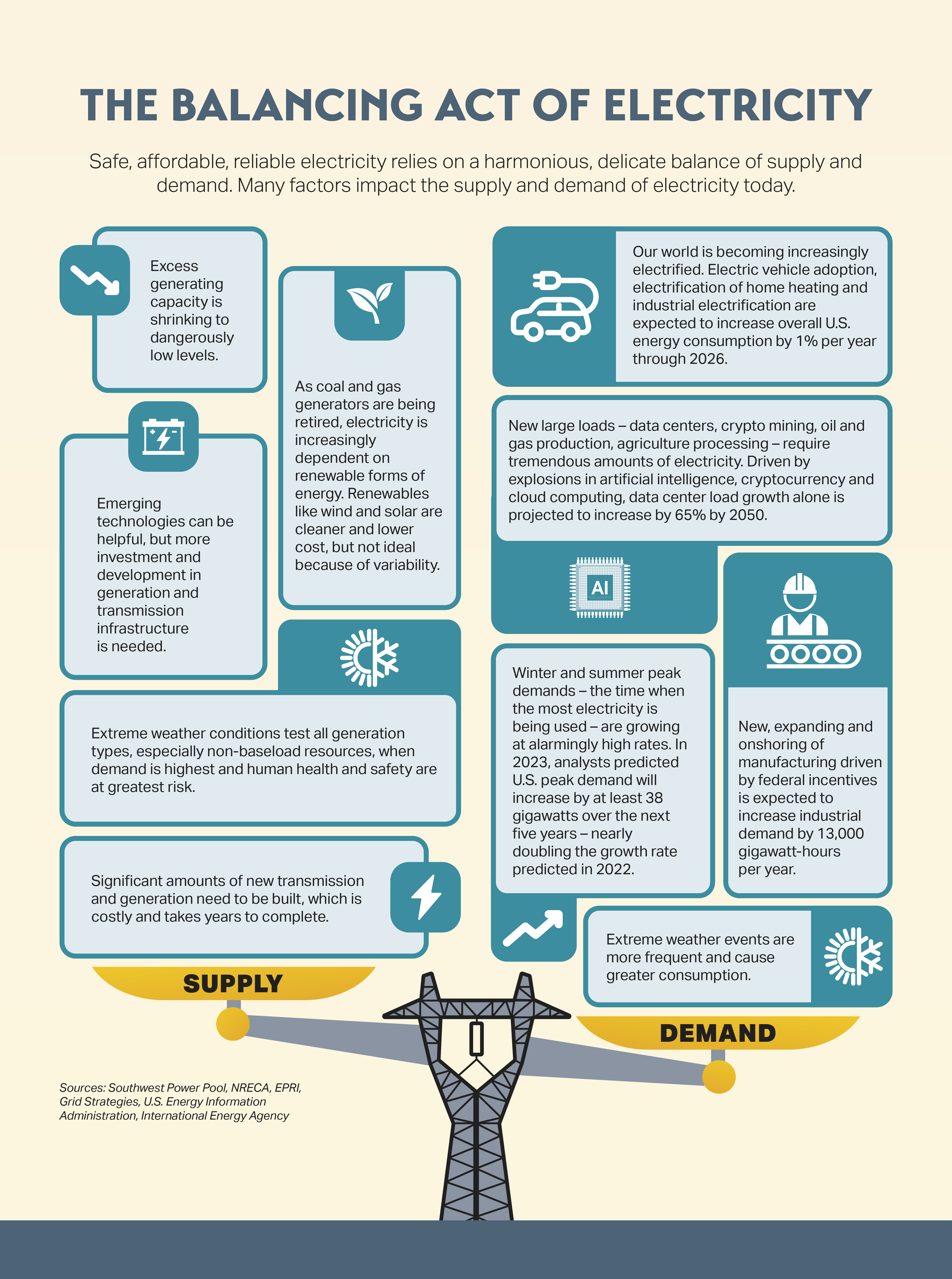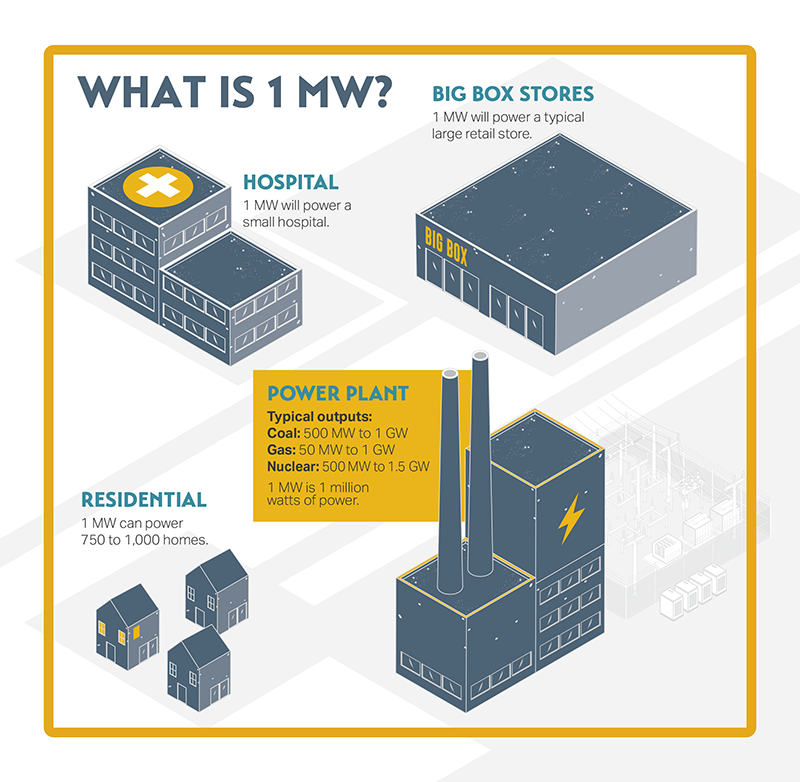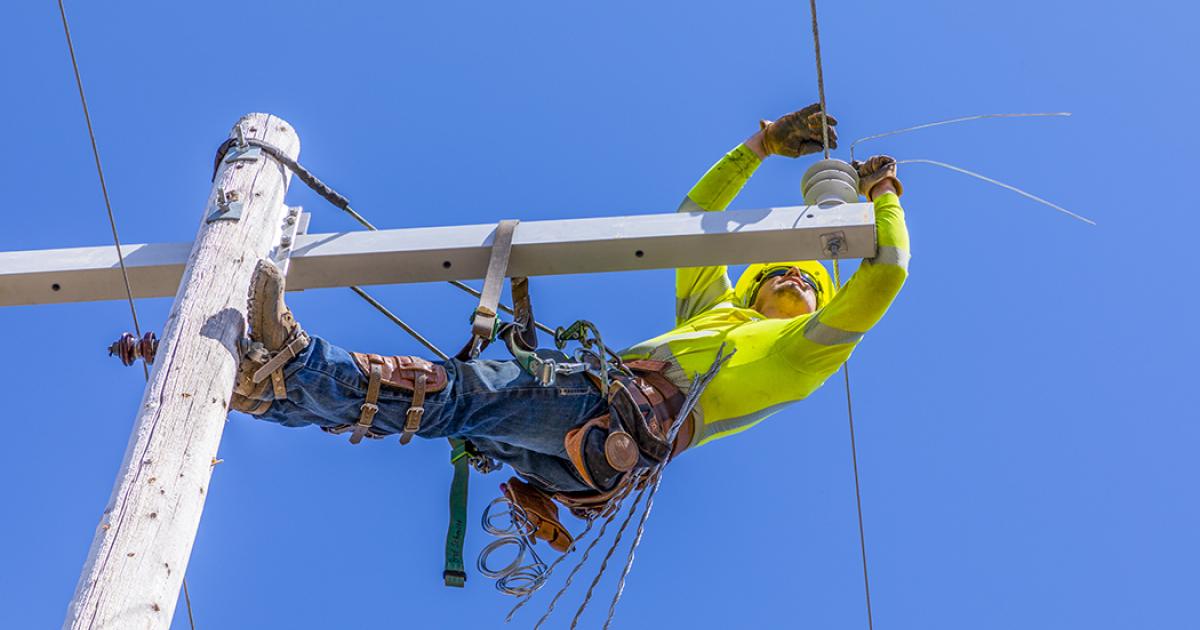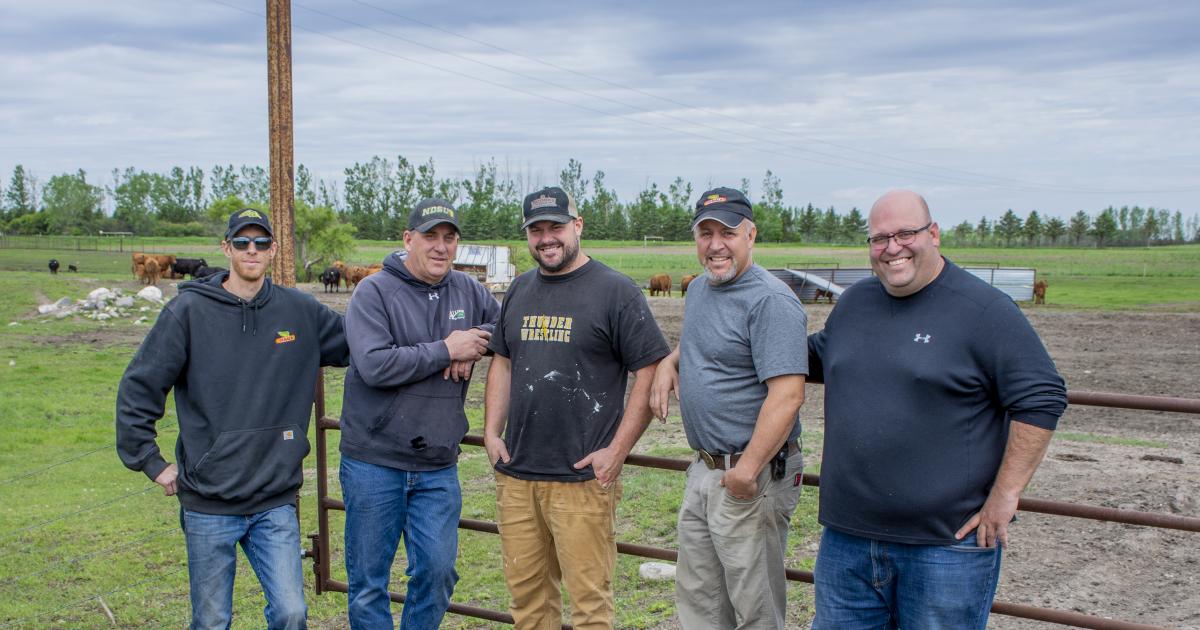Balancing supply and demand

After decades of flat or declining electricity demand, the United States is in an energy demand boom. Recent data suggests power consumption nationwide will increase by at least 38 gigawatts (GW) between now and 2028. That’s the equivalent of adding another California to the nation’s power grid.
At the same time, power producers plan to retire 115 GW of always-available, baseload generation by 2034 – coal, natural gas and nuclear – and the replacement generation comes largely from low or intermittent capacity resources – solar and wind.
“The generation additions and subtractions don’t add up,” says Tony Clark, former N.D. Public Service Commissioner who now serves as executive director of the National Association of Regulatory Utility Commissioners (NARUC). “You can only operate like that for so long before it affects reliability and affordability.”
That’s a message electric cooperatives nationwide have been heralding for years – even before explosive data center growth.
“(Electric cooperatives) were the voice that put reliability back in the conversations in Washington,” says Louis Finkel, senior vice president of government relations for the National Rural Electric Cooperative Association (NRECA). “These conversations were happening before data centers. Co-ops were talking about demand outpacing supply even before demand increases from data centers.”
What’s driving demand growth? Is the United States facing a future energy shortage? How will these challenges affect electric cooperatives and their members?
EXPLOSIVE DEMAND
U.S. demand for electricity is projected to grow 1% to 2% a year for the foreseeable future. That may not seem like a lot, but consider the recent historical average: 0.5%.
“That’s a doubling to quadrupling for demand growth (each year) over what we’ve seen for many decades,” Clark says.
Across the country, demand growth is being driven primarily by home and transportation sector electrification and large commercial users of electricity in the manufacturing, processing, oil and gas, and tech industries. Data centers pose the largest – and perhaps most difficult to predict – demand growth projections.
 |
| POWER- AND FIBER-HUNGRY DATA CENTERS Data centers are facilities that store, process and analyze data to meet modern society’s computing needs. From a web search on your smartphone to storing photos in the cloud, data centers full of servers, storage hardware and digital infrastructure work behind the scenes to make it happen. Data centers consume large amounts of electricity and require the highest connectivity. A decade ago, data centers being constructed had peak electric loads of 10 to 20 megawatts (MW). Those facilities are now being designed for 100 MW or more. In North Dakota, for example, Applied Digital has facilities in Jamestown and Ellendale. Once fully operational, its combined electric load will be 286 MW. The company recently announced plans to expand the Ellendale campus to 400 MW. “Just Google alone uses as much energy as the entire state of North Dakota in a year,” says Tony Clark, former N.D. Public Service Commissioner and executive director of the National Association of Regulatory Utility Commissioners. The hyperscalers – large data centers – also want dedicated fiber strands with asks not seen before in the broadband industry. “They’re asking for 40 100-gig connections,” says Seth Arndorfer, CEO of Dakota Carrier Network. To put that into perspective, local telecommunications cooperative BEK Communications – which has been recognized as the fastest fiber provider in North Dakota – offers up to 2.5-gigabit internet over its fiber network. Data centers are asking for 1,600 times more capacity than the fastest fiber provider in North Dakota! Look for a larger feature story on data centers in an upcoming issue of North Dakota Living. |
Collectively, data centers account for 2% of total U.S. electricity use. By 2030, data centers are projected to consume 9% of all electricity in the country.
“Just Google alone uses as much energy as the entire state of North Dakota in a year,” Clark says.
North Dakota has the potential to see tremendous load growth from data centers. The state is appealing for many reasons, but its cold climate ranks high on the list. Data centers generate significant heat, and North Dakota’s cold climate acts as natural cooling to keep equipment functioning optimally, while reducing energy consumption and cooling costs.
But even without data centers, North Dakota continues to experience a steady rise in electric demand.
“Demand continues to be very high for (western North Dakota), and at a much higher pace than most of the country, due to oil, gas and pipeline growth,” says Jeremy Mahowald, general manager of Upper Missouri Power Cooperative.
Upper Missouri is a power supplier to 11 electric cooperatives in western North Dakota and eastern Montana. Its footprint covers an area the size of Iowa or New York state. Though its service area population and energy needs were historically low, oil and gas development in the region rewrote the co-op’s story.
Twenty years ago, Upper Missouri sold 1.4 billion kilowatt-hours (kWh) of electricity to its members. Last year, the cooperative’s sales totaled 15.1 billion kWh.
“Our future growth forecasts continue to be high, and at a similar growth rate to what we’ve been seeing for oil and gas growth,” Mahowald says. “Most of that oil and gas gets shipped by pipeline and rail out of the region. However, in the future we expect to utilize more gas and oil locally, including refineries, byproduct development and electric gas generation. We also expect our region to be of large interest in locating data center and cryptocurrency growth in the years ahead.”
| PEAK DEMAND 101 Peak demand is a figure closely watched in the utility industry. This is when the demand for electricity is highest. The hottest day of the summer, when air conditioners are on overdrive, and the coldest day of the winter, when home heating is working hardest, are generally when summer and winter peaks occur. Much of the day-to-day and long-term planning by grid operators and utilities centers around peak demand: forecasting what it will be, when it will happen, what resources will be required to meet it and how weather may impact it. What it boils down to is ensuring there is enough supply to meet peak demand. When there is not enough electricity to meet demand, grid operators must adjust the load. Essentially, that means shutting off power. Why does peak demand matter? Because it is reflected in the price consumers pay for electricity. The price of electricity is typically highest when demand is highest, so when consumers use electricity during peak demand times, they are using the highest-cost power. How peak demand is accounted for on electric bills varies from utility to utility. Contact your electric cooperative to learn more about local peak demand times, your electric bill or ways to reduce your electric usage. |
 |
As energy demand grows, so does peak demand – when the demand for and price of electricity is highest. Winter and summer peak demands are growing at alarmingly high rates. In 2023, analysts predicted U.S. peak demand will increase by at least 38 GW over the next five years – nearly doubling the growth rate predicted in 2022.
“Upper Missouri has a high load factor throughout the year with most oil and gas operations running 24/7, however, it is winter peaking due to electric heat,” Mahowald says. “Twenty years ago, in 2005, we peaked at 248 MW. Last year, in 2024, we peaked at 2,030 MW.”
So, is all this demand growth a good thing?
“Stable growth is generally good for any cooperative, as it can serve as a hedge to rising costs of materials and labor,” Mahowald says. “This varies, however, depending on the level of investment asked by their members in costs of construction, which is common practice at the distribution cooperative level, but has not been the practice for generation or major transmission construction. Vastly rising costs in combination with a high-growth trajectory bring the promise of future sales, but also have the impact of rising electricity rates to cover higher capital expenditures.”

SIGNIFICANT SUPPLY SIDE CHALLENGES
Capitalizing on demand growth opportunities will require overcoming significant challenges on the supply side of the equation.
“There are a broad number of issues facing power supply in the United States,” Mahowald says. “In the last several years, we’ve seen a major increase in renewables, while at the same time watching a rapid decline in baseload coal and even nuclear generation, mostly due to social, political, regulatory and environmental factors. Today, we see a lot of new development throughout the country in gas generation, though at much higher than historical costs due to a heavy demand for new generation.”
Echoing Mahowald, the U.S. electric reliability watchdog, the North American Electric Reliability Corporation, describes the challenges in its 2024 Long-Term Reliability Assessment released in December:
• Accelerated retirements of existing coal, natural gas and nuclear generators
• A more variable, weather-dependent, natural-gas reliant and higher-risk resource mix
• Influence of environmental regulations, energy policies and economic factors
• Declining reserve margins
• Resource and transmission development
• Planned generation resources in the interconnection queue look “alarmingly unreliable”
BUILDING GENERATION AND TRANSMISSION
Careful planning and significant generation and transmission infrastructure investments will be required to ensure a reliable supply of electricity.
Zachary Zimmerman of Grid Strategies estimates the buildout of generation and transmission infrastructure will need to occur six times faster than the current rate to meet future demand, and U.S. transmission capacity will need to double or triple in 10 to 20 years.
Yet, less than one-fifth of generation capacity projects seeking interconnection between 2000 and 2018 actually came to fruition by the end of 2023, according to an April 2024 report from the Lawrence Berkeley National Laboratory. The same study found the time between initiating an interconnection request to the start of commercial operations increased from two years to more than four years.
To further complicate matters, utilities and grid planners are being asked to make 35-year decisions and infrastructure investments under a four-year energy policy, electric cooperative leaders say.
“There is so much uncertainty and risk with picking the wrong (generation) technology to invest in,” Clark says.
And, building the transmission to get the power from where it’s made to where it’s needed is a lot harder today.
“Building transmission today has changed in many ways from 50 years ago,” Mahowald says. “From outward appearances, transmission structures and substations haven’t changed much over the years. However, reliability and environmental requirements are greater, easements are more difficult to obtain and many study processes are needed, also making them more expensive than they used to be.”
Clark says transmission projects take 10 to 15 years to build today, in a best-case scenario.
“I’ve sited a lot of projects over the years. As difficult as a pipeline is to get built, transmission is way harder,” Clark says. “A pipeline, once it’s built, you can farm over it. But transmission, the farmer sees it and has to farm around it.”
“Upper Missouri, or any cooperative or utility for that matter, is affected directly or indirectly by all permitting and regulations. Mostly, these regulations impact our cost of power and the timelines to get projects done,” Mahowald says.
A positive development is recent action by the Environmental Protection Agency (EPA), which would be a key victory for reliability and alleviate cost challenges for electric cooperatives, NRECA CEO Jim Matheson says. EPA said it will review and reconsider the Biden administration’s power plant greenhouse gas rule, as well as the mercury and air rule, ozone transport rule and power plant wastewater rule. The EPA’s power plant rules would force the premature retirement of reliable, dispatchable, baseload coal and natural gas generation assets.
“(The March 14) EPA announcements are another critical step that puts our nation on a path toward a more reliable and resilient electric grid – and not a moment too soon,” Matheson says. “Electricity demand is skyrocketing, yet bad public policy decisions are forcing always-available generation resources to retire faster than they can be reliably replaced.”
CAN CO-OPS MEET THE CHALLENGES?
North Dakota’s electric cooperatives have a track record of rising to meet the challenges of the day – while not seeking the credit.
An under-told success story is the generational investments made by electric cooperatives to build out distribution, transmission and generation infrastructure to serve the Bakken region. Upper Missouri, Basin Electric Power Cooperative and small-but-mighty distribution cooperatives across western North Dakota and eastern Montana collectively invested billions of dollars to serve the oil and gas industry.
Mountrail-Williams Electric Cooperative in Williston grew from a $30 million, 50 MW electric co-op in 1991 to a more than $350 million, 775 MW one in 2023.
In the last 10 years, McKenzie Electric Cooperative in Watford City planned for and brought on almost 600 MW of new load, successfully navigating double-digit annual growth rates without significant impact to its existing legacy members.
Basin Electric is investing almost $8 billion over the next 10 years in transmission and generation assets. In January, the cooperative announced plans to build a nearly $4 billion, 1,470-megawatt natural gas-fueled generation facility in Williams County – one of the largest electric generation projects in Basin Electric’s history.
In many ways, North Dakota’s electric cooperatives have an advantage when it comes to meeting electric supply and demand challenges now and in the future – because they’ve done it before. And while there are headwinds beyond cooperatives’ control, the cooperative model has proven time and again it is up for the challenge.
“There is significant work and large investments required to keep up with our growing electricity needs. I am confident we can meet the needs successfully and equitably, giving strength to our cooperative family, local economies and to the state of North Dakota,” Mahowald says.
___
Cally Peterson is editor of North Dakota Living. She can be reached at cpeterson@ndarec.com.
EDITOR’S NOTE:
In North Dakota, electric cooperative rate making is a function of local electric co-op boards of directors, which are democratically elected from the membership by the co-op members. Electric co-op boards weigh many factors when determining rates and balancing reliability, safety and affordability.
Across the country, many electric cooperatives (though not all) have implemented, are considering or will consider a rate increase. The Cost of Your Power series has presented some of the current industry-wide, high-level pressures which factor into rate-making decisions by electric cooperative boards. This series did not include information specific to your local electric cooperative. Contact your local electric cooperative for information about your electric rates.










